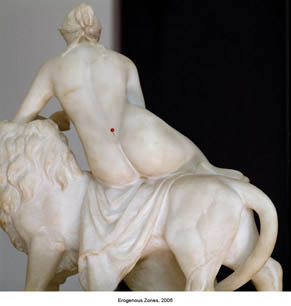Dubravka Vidovic
dal 20/12/2006 al 20/1/2007
Segnalato da
20/12/2006
Dubravka Vidovic
Galerija umjetnina di Zadar, Zadar
Formae Mentis. The artist expresses herself in different media, using photography or video in the manner of contemporary artistic practice, with connections with performance/staged art. In these works the author makes collages, intervenes with words, arranges the situation which she afterwards fixates through photography.

Formae Mentis
Formae mentis is an exhibition of the work of Dubravka Vidović who was awarded first prize at the 11th Zadar Salon of young artists organized by the Art Gallery of the National Museum Zadar (Croatia).
D. Vidović expresses herself in different media, photography, video, installations. Using photography or the video she does this in the manner of contemporary artistic practice which has connections with performance/staged art.
For example, when she uses the body as a medium in the video-work Crossing Shores Through where there is no direct contact with the public, where the performance is medialized, digitalized, where it becomes transferable. In the Student Center Gallery (the work View) she does not stand with a hat, covering a part of her face, looking out at the public, as was the case in original performance or action art but she rather photographs her face in three sequences and equips her work with an additional language commentary which challenges us to look at things in a new manner. Her photographs are technically perfect, without effects, without software processing, reduced as though she was hiding the photographic medium in order to strengthen the message.
In the cycle of photographs Erogenous Zones the author employs models for her photography of women from different periods and made of various materials - of stone, marble, ivory which was used to make an 18th century English paper cutting knife on whose handle lies a female figure. One also finds a small Chinese female figure as well as an item which women carried to their physicians which helped them to point to painful places without undressing … The woman is incarnated in solid material pricked with red top dressmaker’s needles, this warm domestic furniture which can bring associations of almost infantile rituals, some sensual tailor’s place, even a spiritual acupuncture that unfolds in the zone of the hidden.
Additionally, the author presents herself with collages for which she found existing models, old photographs, of which some derive from the photography collection in the Zadar Gallery of Art so that we can label them as site specific collages.
In these works the author makes collages, intervenes with words, arranges the situation which she afterwards fixates through photography. She adds a bunch of daisies to a photograph of two girls which amounts to a kind of natural ready made (as the shell in Natural Ready Made from 2001) and which will wither during the duration of the exhibition transforming the work into a memento of time. Through a procedure of re-contextualization the author manipulates time, beckons to the past, “appropriates forms and characters", assigning them new meanings.
The questioning of identity finds its place in the work of this author positioning it within the rich current of contemporary artistic practice which deconstructs the things we believe to be “givens", “natural", “axioms".
What is involved in these works is the hidden, the mental space where “deep/timeless memory and instantaneous/temporal memories" (F. Naldi) meet as well as the duplication of identity but not in the sense of playing different roles but rather in overcoming the physical and the mental. Her artistic world traverses the divide between the permanent and the temporary, the eternal and the temporal, between solidity and pliancy, the physical and the mental, the past and the presence, reality and dreams, “that boundary space where the unimaginable can happen".
In such a manner the author (by way of discrete lexical interventions in the third class passenger’s menu) transforms the ready made from the past, the menu from the end of the 18th century cruiser, into an artistic object in the work Troisieme class which, in addition to addressing the marginal social position of third class passengers, also becomes a part of formae mentis.
Namely, the dictionary of meals becomes a dictionary of conditions, the real and the virtual touch in lexical/poetic syntagms: coffee made of shadows, chocolate of dreams, butter of clouds, oranges of tomorrow’s sun, milk made of snow. Dualism as the basis of Western, logocentric thought, which in large part determines our own way of thinking, is transcended by artistic activity which creates a common space of art in which both the artist and the observer participate.
There “the authentic beauty of the world (…) the flickering of the unutterable, the dialogue between the dead and the living contemporaries" (Ž. Paić) takes place. In a world swamped by the inflation of images where we are every day exposed to the exposures of Big Brother, where the reality show has become a surrogate for life, formae mentis, by way of the procedure of “defamiliarization", challenge our perception, map the road to the “hidden".
Ljubica Srhoj Čerina
Galerija umjetnina di Zadar
Meduliceva 2 - Zadar



